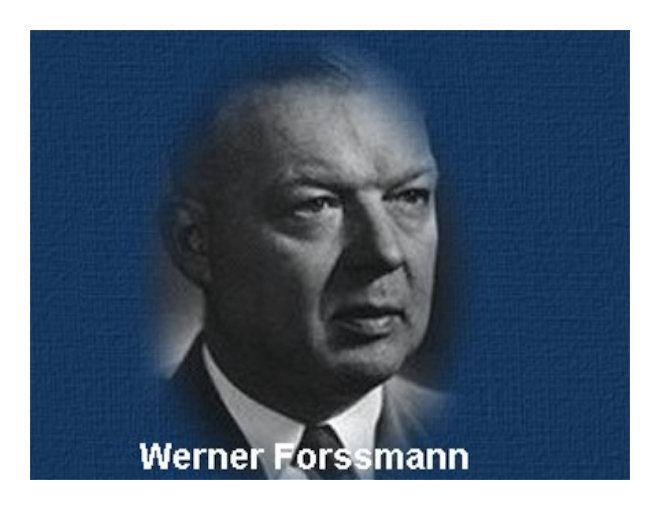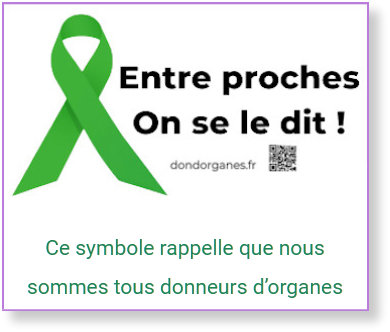Werner Forssmann
Célébrités en cardiologie
(Celebrities in cardiology)

Werner Theodor Otto Forssmann © Heart and Coeur ©
 Werner Theodor Otto Forssmann
Werner Theodor Otto Forssmann
FORSSMAN est le premier a développer une technique de cathéterisation
Werner Theodor Otto Forssmann est né Berlin le 29 Aout 1904 et mort en 1979
Né à Berlin le 29 aout 1904, fils de Jules Forssmann et de Emmy Hindenberg.
Il a rejoint en 1922, l'université de Berlin pour étudier la médecine, passant son examen d'état en 1929.
Pour sa formation il est allé à la clinique médicale d'université,travaillant sous la tutelle du professeur Georg Klemperer, et il a étudié l'anatomie sous celle du professeur Rudolph Fick.
Pour sa formation de chirurgie il est entré, en Aout 1929, à Victoria à Eberswalde prés de Berlin.
Werner Theodor Otto FORSSMAN est le premier a développer une technique de cathéterisation du coeur.
Voici ce qu'il fit:
Il inséra une cannule dans sa propre veine "antecubital", dans laquelle il passa un cathéter de 65 centimétres de long et il est allé au service de "radiologie", où il photographia le cathéter situé dans son oreillette droite...
Plus tard il travailla , à Berlin, et à l'hôpital de la ville de Mayence, ensuite il est allé à l'hôpital de Rudolf Virchow à Berlin pour la formation de spécialiste en urologie sous la direction du Dr. Karl Heusch.
Il a été nommé chef de la clinique chirurgicale de l'hôpital de la ville de Dresde-Friedrichstadt et à l'hôpital de Robert Koch, à Berlin.
Au début de la deuxiéme guerre mondiale, Forssmann servi comme officier sanitaire, atteignant le grade de Chirurgien-Principal; mais il fut prisonnier de guerre jusqu'a la libération en en 1945.
Il vécu avec son épouse, dans le Schwarzwald.
A partir de l'année 1950 il travailla en tant que spécialiste en urologique à Bad-Kreuznach, et en 1958 il fut chef de la Division chirurgicale de l'hôpital évangélique de la ville de Dusseldorf, où il vécu .
En 1956 on lui décerne, ainsi qu'André Cournand et Dickinson W. Richards, le prix Nobel , la même année il est nommé professeur honorifique de chirurgie et d'urologie à l'université de Johannes Gutenberg, (Mayence).
-Médaillé de Leibniz de l'académie allemande des sciences;
-Invité d'honneur à l'université nationale de Cordoue, Argentine, où il a été nommé professeur honorifique en 1961.
-Il aussi membre du conseil exécutif de la société chirurgicale allemande.
-Il est également membre de l' "American College of Chest Physicians",
-Membre honorifique de la société suédoise de la cardiologie,
-Membre de la société allemande d'urologie,
-Membre de l'association allemande d'assistance sociale pour enfant.
 Werner Forssmann
Werner Forssmann
He was the first to develop a technique for the catheterization of the heart
Werner Theodor Otto Forssmann was born in Berlin on August 29, 1904,
the son of Julius Forssmann and Emmy Hindenberg. He was educated at the Askanische Gymnasium (secondary grammar school) in Berlin.
Leaving school in 1922, he went to the University of Berlin to study medicine, passing his State Examination in 1929.
For his clinical training he went to the University Medical Clinic, working under Professor Georg Klemperer, and he studied anatomy under Professor Rudolph Fick. For clinical instruction in surgery he went, in 1929, to the August Victoria Home at Eberswalde near Berlin.
It was here that he was the first to develop a technique for the catheterization of the heart.
This he did by inserting a cannula into his own antecubital vein, through which he passed a catheter for 65 cm and then walked to the X-ray department, where a photograph was taken of the catheter lying in his right auricle.
Subsequently he worked at the Charité, Berlin, and the City Hospital at Mainz, and then went to the Rudolf Virchow Hospital in Berlin for specialist training in urology under Dr. Karl Heusch. He was appointed Chief of the Surgical Clinic of the City Hospital at Dresden-Friedrichstadt and at the Robert Koch Hospital, Berlin. At the beginning of the Second World War, Forssmann served as a Sanitary Officer, reaching the rank of Surgeon-Major; but he became a prisoner of war until his release in 1945, when he went into practice with his wife, in the Schwarzwald.
From 1950 onwards he practised as a urological specialist at Bad Kreuznach, and since 1958 he has been Chief of the Surgical Division of the Evangelical Hospital at Düsseldorf, where he now lives.
In 1956 he was awarded, together with André Cournand and Dickinson W. Richards, the Nobel Prize for Physiology or Medicine and he was, in the same year, appointed Honorary Professor of Surgery and Urology at the Johannes Gutenberg University, Mainz.
In 1954 he was awarded the Leibniz Medal of the German Academy of Sciences; in the same year he was Guest of Honour at the National University of Cordoba, Argentina, where he was appointed Honorary Professor in 1961.
Since 1962 he is a Member of the Executive Board of the German Surgical Society. He is also a Member of the American College of Chest Physicians, and Honorary Member of the Swedish Society of Cardiology, the German Society of Urology, and the German Child Welfare Association.
http://www.nobel.se/medicine/laureates/1956/forssmann-bio.html



